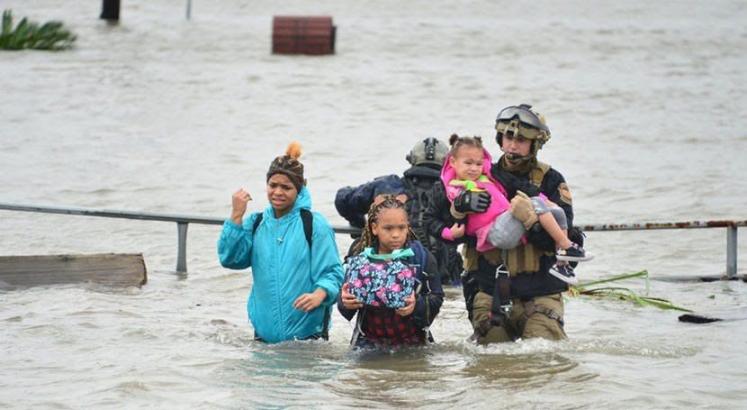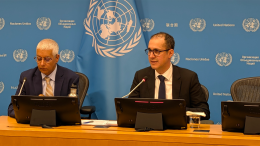Millions of Americans live behind the nation’s aging levees for protection from floods. But their health, safety, and assets are not equally threatened by the risk of levee failure. A new report by the United Nations University Institute for Water, Environment and Health (UNU-INWEH) — “Inequity behind levees: the case of the United States of America” — conclusively underscores an unsettling yet pronounced inequitable disposition of socially vulnerable and underserved communities situated behind the US levee system.
Building earthen embankments and levees has been a traditional way for humans around the world to protect their settlements from floods. In the United States, many levees were built by farmers and early settlers to protect their farmland and animal livestock from floods. With population growth, more Americans started residing behind these levees. So, they unintendedly became the backbone of the nation’s flood management system.
Estimates suggest that two-thirds of the US population now relies on levees for flood protection. However, a major part of these aging levees was built many years ago without rigorous design and construction standards. Thus, with an average age of 57 years, they are near the end of their service life and extremely substandard. This puts millions of Americans at risk of levee failure and catastrophic flooding, like the recent breach of the Pajaro Levee in California in March 2023.
In 2005, the failure of 50 levees and flood walls in Louisiana led to one of the costliest floods in the United States, affecting 134,000 households and killing around 1400 people. The cost of flooding in the U.S. is $32 billion per year and is expected to reach $40 billion by 2050. Sea level rise along with more frequent and intense floods and hurricanes seriously threaten the inadequate flood protection of the United States, putting millions of people and their assets in great danger.
The new study uncovers the major injustice implications of the decaying levees in the United States. Comparing the social, economic, and demographic characteristics of the people living behind levees with those who don’t reside behind levees, the researchers made a worrying observation: historically underserved and socially vulnerable communities in the U.S. have high population concentrations behind levees.
The report found that racial and ethnic minority groups, poor households, disabled persons, and people without high school diplomas are overrepresented in leveed communities in comparison to non-leveed communities. “These people will suffer more from floods and climate change”, said Farshid Vahedifard, the Resilient and Equitable Infrastructure Lead at UNU-INWEH and a Professor of Tufts University who led this investigation. “Their barriers and limitations restrict their capacity to cope with future hazards and disasters.”
The report found that disadvantaged communities and population groups are overrepresented behind levees in 43 states. At the US national level, the overrepresentation of these groups is 41% higher. Hispanics were found to be the most overrepresented ethnic group with a 40% higher rate of presence behind levees, followed by Native American (19%), Asian (18%), and Black (16%) communities.
According to the study results, communities with low education, poverty, and disability have a disproportionately higher presentation of 28%, 20%, and 5% in leveed areas across the U.S. At the regional level, the highest disparity is in the Northeast (57%), followed by the West (51%), Southeast (38%), Midwest (29%), and Southwest (25%). Black people are overrepresented in the US Midwest (61%) and Southeast (40%). In the Western US, the largest disparities are related to people with low levels of education (41%) and Hispanic or Latino populations (39%).
The UNU report warns that the existing socio-economic and demographic disparities must be urgently considered in flood management and climate change adaptation decisions to minimize inequity. “This report calls for a fundamental reform in existing flood management paradigms as the world prepares to take serious climate actions,” said UNU-INWEH Director Prof. Kaveh Madani. “Flood management decisions have been traditionally focused on minimizing the economic cost of natural disasters. This type of decision-making brutally ignores the human element of disasters, leading to increased inequalities and injustice.”
While the study findings are worrying, the authors hope their developed toolset can help governments around the world identify and prioritize those groups and areas that are in urgent need of infrastructure resilience investments. The report calls for targeted action to ensure that future flood mitigation and climate change adaptation strategies prioritize those most at risk. “We must incorporate the principles of environmental justice into future decision-making regarding flood management and infrastructure resilience under climate change,” said Vahedifard. “We must appreciate different vulnerability levels across population groups and help more those who are in need of greater help.”
The new UNU report is focused on the United States but emphasizes the global nature of the revealed problem. While many environmental justice studies are focused on the Global North, the researchers intended to show that the justice and equity gaps in water management and climate change adaptation are significant even in the Global North and Advanced economies. “This study just revealed the tip of the iceberg, but it’s a constructive step toward building a just and inclusive future for all”, said Madani.
Key Findings
- Historically underserved and socially vulnerable communities are substantially over-represented in levee-protected areas at the national, regional, and state levels within the United States
- Disadvantaged communities are overrepresented behind levees in 43 states with a national disparity of 41%.
- Regionally, the highest disparities exist in the Northeast (57%), followed by the West (51%), Southeast (38%), Midwest (29%), and Southwest (25%).
- In terms of race and ethnic composition, Hispanic communities are most overrepresented in leveed areas (40%), followed by Native American (19%), Asian (18%), and Black (16%) communities.
- Residents in levee-protected communities exhibit disproportionately low educational attainment (28%), poverty (20%), and disability (5%) when compared to residents in communities not protected by levees.
- At the national level, Black and Asian populations exhibited disproportionate representation behind high to very high-risk levees, with disparity percentages of 74% and 69%, respectively.
- Substantial overrepresentation of Native Americans was found in areas protected by non-classified levees (83%), and non-accredited levees (77%).
- Black populations have the highest disparity in US Midwestern states (60%).
- Hispanic communities have a disparity percentage of 60% in Southeast states.
- 41% more low-income families live behind levees than non-leveed areas in western states.
- Disparity percentage of people with disability who live behind levees reaches 30% in the Northeast.
- High levels of disparity were found for black populations in Kentucky (284%) and Tennessee (156%).In Utah, Connecticut, Rhode Island, and Georgia, disadvantaged populations are two times bigger in the leveed zones. This difference is 6 times bigger in the case of Vermont.
###
Media Contacts
- Kyra Bowman, bowman@unu.edu
- Maryam Mottalebi, maryam.mottalebi@unu.edu
The UNU research team is available for interviews:
- Prof. Farshid Vahedifard, Lead, Resilient and Equitable Infrastructure, UNU-INWEH, farshid.vahedifard@unu.edu
- Prof. Kaveh Madani, Director, UNU-INWEH, kaveh.madani@unu.edu





